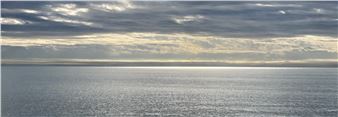The Left Front: Radical Art in the “Red Decade,” 1929-1940
This exhibition revisits a moment in American cultural history when visual artists joined forces to form a “left front” with writers and intellectuals dedicated to making socially conscious art. In the wake of the Wall Street crash of 1929, there emerged a generation of artists who used art as a catalyst for social change. Named after the journalist-activist who witnessed and wrote about the 1917 Russian Revolution, John Reed Clubs spread across the country, numbering about thirty chapters nationwide. Chicago in particular became a breeding ground for politically charged art.
John Reed Club artist-members embraced the motto “art as a social weapon,” and their manifesto called on artists to “abandon decisively the treacherous illusion that art can exist for art’s sake, or that the artist can remain remote from the historic conflicts in which all men must take sides.” They took their message to the streets—marching, boycotting, picketing, and teaching—while also organizing exhibitions and publishing their artworks. This exhibition explores the visual arts legacies of the John Reed Club and its successor organization, the American Artists’ Congress.
In light of the recent global recession, artworks by artist-activists of the 1930s take on a new vividness, serving as a resource for understanding artists’ responses to moments of social, political, and economic crisis. In 1930, artists asked, “What should revolutionary artists do now?” In conjunction with the Left Front exhibition, the Block has invited contemporary artists and other cultural workers based in Chicago to respond to the question “What is revolutionary art?” Their responses, some printed in the free exhibition newspaper, suggest that the question is alive today as artists continue to critically consider the social responsibility of art.
“The Left Front” highlights Chicago-based members of the John Reed Club and the American Artists’ Congress, considering specific conditions of the city -- its industrial legacy, massive immigration, ethnic neighborhoods, historical association with anarchism and labor unrest, and commitment to social reform through institutions like Jane Addams Hull House -- as the backdrop against which their work evolved. The exhibition brings together artists with Chicago connections, including Morris Topchevsky, Henry Simon, Mitchell Siporin, Bernece Berkman and Carl Hoeckner.

Recommended for you
This exhibition revisits a moment in American cultural history when visual artists joined forces to form a “left front” with writers and intellectuals dedicated to making socially conscious art. In the wake of the Wall Street crash of 1929, there emerged a generation of artists who used art as a catalyst for social change. Named after the journalist-activist who witnessed and wrote about the 1917 Russian Revolution, John Reed Clubs spread across the country, numbering about thirty chapters nationwide. Chicago in particular became a breeding ground for politically charged art.
John Reed Club artist-members embraced the motto “art as a social weapon,” and their manifesto called on artists to “abandon decisively the treacherous illusion that art can exist for art’s sake, or that the artist can remain remote from the historic conflicts in which all men must take sides.” They took their message to the streets—marching, boycotting, picketing, and teaching—while also organizing exhibitions and publishing their artworks. This exhibition explores the visual arts legacies of the John Reed Club and its successor organization, the American Artists’ Congress.
In light of the recent global recession, artworks by artist-activists of the 1930s take on a new vividness, serving as a resource for understanding artists’ responses to moments of social, political, and economic crisis. In 1930, artists asked, “What should revolutionary artists do now?” In conjunction with the Left Front exhibition, the Block has invited contemporary artists and other cultural workers based in Chicago to respond to the question “What is revolutionary art?” Their responses, some printed in the free exhibition newspaper, suggest that the question is alive today as artists continue to critically consider the social responsibility of art.
“The Left Front” highlights Chicago-based members of the John Reed Club and the American Artists’ Congress, considering specific conditions of the city -- its industrial legacy, massive immigration, ethnic neighborhoods, historical association with anarchism and labor unrest, and commitment to social reform through institutions like Jane Addams Hull House -- as the backdrop against which their work evolved. The exhibition brings together artists with Chicago connections, including Morris Topchevsky, Henry Simon, Mitchell Siporin, Bernece Berkman and Carl Hoeckner.
Artists on show
Contact details














